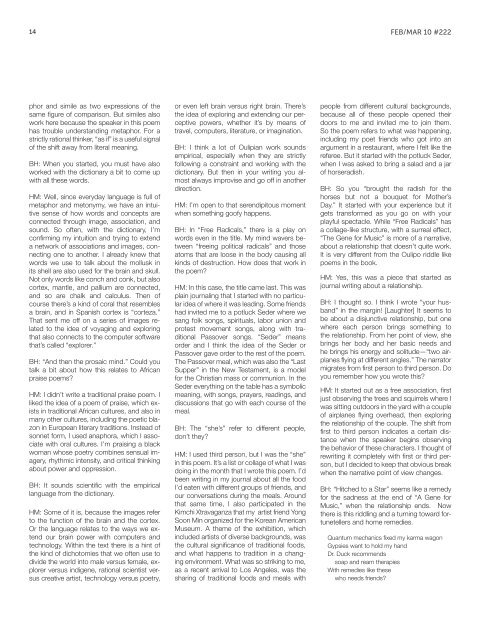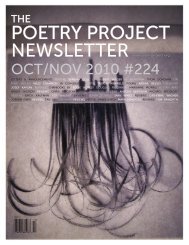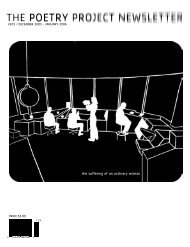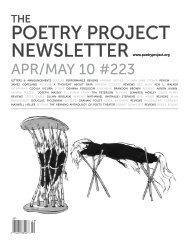You also want an ePaper? Increase the reach of your titles
YUMPU automatically turns print PDFs into web optimized ePapers that Google loves.
14 FEB/MAR 10 #222<br />
phor and simile as two expressions of the<br />
same figure of comparison. But similes also<br />
work here because the speaker in this poem<br />
has trouble understanding metaphor. For a<br />
strictly rational thinker, “as if” is a useful signal<br />
of the shift away from literal meaning.<br />
BH: When you started, you must have also<br />
worked with the dictionary a bit to come up<br />
with all these words.<br />
HM: Well, since everyday language is full of<br />
metaphor and metonymy, we have an intuitive<br />
sense of how words and concepts are<br />
connected through image, association, and<br />
sound. So often, with the dictionary, I’m<br />
confirming my intuition and trying to extend<br />
a network of associations and images, connecting<br />
one to another. I already knew that<br />
words we use to talk about the mollusk in<br />
its shell are also used for the brain and skull.<br />
Not only words like conch and conk, but also<br />
cortex, mantle, and pallium are connected,<br />
and so are chalk and calculus. <strong>The</strong>n of<br />
course there’s a kind of coral that resembles<br />
a brain, and in Spanish cortex is “corteza.”<br />
That sent me off on a series of images related<br />
to the idea of voyaging and exploring<br />
that also connects to the computer software<br />
that’s called “explorer.”<br />
BH: “And then the prosaic mind.” Could you<br />
talk a bit about how this relates to African<br />
praise poems?<br />
HM: I didn’t write a traditional praise poem. I<br />
liked the idea of a poem of praise, which exists<br />
in traditional African cultures, and also in<br />
many other cultures, including the poetic blazon<br />
in European literary traditions. Instead of<br />
sonnet form, I used anaphora, which I associate<br />
with oral cultures. I’m praising a black<br />
woman whose poetry combines sensual imagery,<br />
rhythmic intensity, and critical thinking<br />
about power and oppression.<br />
BH: It sounds scientific with the empirical<br />
language from the dictionary.<br />
HM: Some of it is, because the images refer<br />
to the function of the brain and the cortex.<br />
Or the language relates to the ways we extend<br />
our brain power with computers and<br />
technology. Within the text there is a hint of<br />
the kind of dichotomies that we often use to<br />
divide the world into male versus female, explorer<br />
versus indigene, rational scientist versus<br />
creative artist, technology versus poetry,<br />
or even left brain versus right brain. <strong>The</strong>re’s<br />
the idea of exploring and extending our perceptive<br />
powers, whether it’s by means of<br />
travel, computers, literature, or imagination.<br />
BH: I think a lot of Oulipian work sounds<br />
empirical, especially when they are strictly<br />
following a constraint and working with the<br />
dictionary. But then in your writing you almost<br />
always improvise and go off in another<br />
direction.<br />
HM: I’m open to that serendipitous moment<br />
when something goofy happens.<br />
BH: In “Free Radicals,” there is a play on<br />
words even in the title. My mind wavers between<br />
“freeing political radicals” and those<br />
atoms that are loose in the body causing all<br />
kinds of destruction. How does that work in<br />
the poem?<br />
HM: In this case, the title came last. This was<br />
plain journaling that I started with no particular<br />
idea of where it was leading. Some friends<br />
had invited me to a potluck Seder where we<br />
sang folk songs, spirituals, labor union and<br />
protest movement songs, along with traditional<br />
Passover songs. “Seder” means<br />
order and I think the idea of the Seder or<br />
Passover gave order to the rest of the poem.<br />
<strong>The</strong> Passover meal, which was also the “Last<br />
Supper” in the New Testament, is a model<br />
for the Christian mass or communion. In the<br />
Seder everything on the table has a symbolic<br />
meaning, with songs, prayers, readings, and<br />
discussions that go with each course of the<br />
meal.<br />
BH: <strong>The</strong> “she’s” refer to different people,<br />
don’t they?<br />
HM: I used third person, but I was the “she”<br />
in this poem. It’s a list or collage of what I was<br />
doing in the month that I wrote this poem. I’d<br />
been writing in my journal about all the food<br />
I’d eaten with different groups of friends, and<br />
our conversations during the meals. Around<br />
that same time, I also participated in the<br />
Kimchi Xtravaganza that my artist friend Yong<br />
Soon Min organized for the Korean American<br />
Museum. A theme of the exhibition, which<br />
included artists of diverse backgrounds, was<br />
the cultural significance of traditional foods,<br />
and what happens to tradition in a changing<br />
environment. What was so striking to me,<br />
as a recent arrival to Los Angeles, was the<br />
sharing of traditional foods and meals with<br />
people from different cultural backgrounds,<br />
because all of these people opened their<br />
doors to me and invited me to join them.<br />
So the poem refers to what was happening,<br />
including my poet friends who got into an<br />
argument in a restaurant, where I felt like the<br />
referee. But it started with the potluck Seder,<br />
when I was asked to bring a salad and a jar<br />
of horseradish.<br />
BH: So you “brought the radish for the<br />
horses but not a bouquet for Mother’s<br />
Day.” It started with your experience but it<br />
gets transformed as you go on with your<br />
playful spectacle. While “Free Radicals” has<br />
a collage-like structure, with a surreal effect,<br />
“<strong>The</strong> Gene for Music” is more of a narrative,<br />
about a relationship that doesn’t quite work.<br />
It is very different from the Oulipo riddle like<br />
poems in the book.<br />
HM: Yes, this was a piece that started as<br />
journal writing about a relationship.<br />
BH: I thought so. I think I wrote “your husband”<br />
in the margin! [Laughter] It seems to<br />
be about a disjunctive relationship, but one<br />
where each person brings something to<br />
the relationship. From her point of view, she<br />
brings her body and her basic needs and<br />
he brings his energy and solitude—“two airplanes<br />
flying at different angles.” <strong>The</strong> narrator<br />
migrates from first person to third person. Do<br />
you remember how you wrote this?<br />
HM: It started out as a free association, first<br />
just observing the trees and squirrels where I<br />
was sitting outdoors in the yard with a couple<br />
of airplanes flying overhead, then exploring<br />
the relationship of the couple. <strong>The</strong> shift from<br />
first to third person indicates a certain distance<br />
when the speaker begins observing<br />
the behavior of these characters. I thought of<br />
rewriting it completely with first or third person,<br />
but I decided to keep that obvious break<br />
when the narrative point of view changes.<br />
BH: “Hitched to a Star” seems like a remedy<br />
for the sadness at the end of “A Gene for<br />
Music,” when the relationship ends. Now<br />
there is this riddling and a turning toward fortunetellers<br />
and home remedies.<br />
Quantum mechanics fixed my karma wagon<br />
Gypsies want to hold my hand<br />
Dr. Duck recommends<br />
soap and ream therapies<br />
With remedies like these<br />
who needs friends?

















